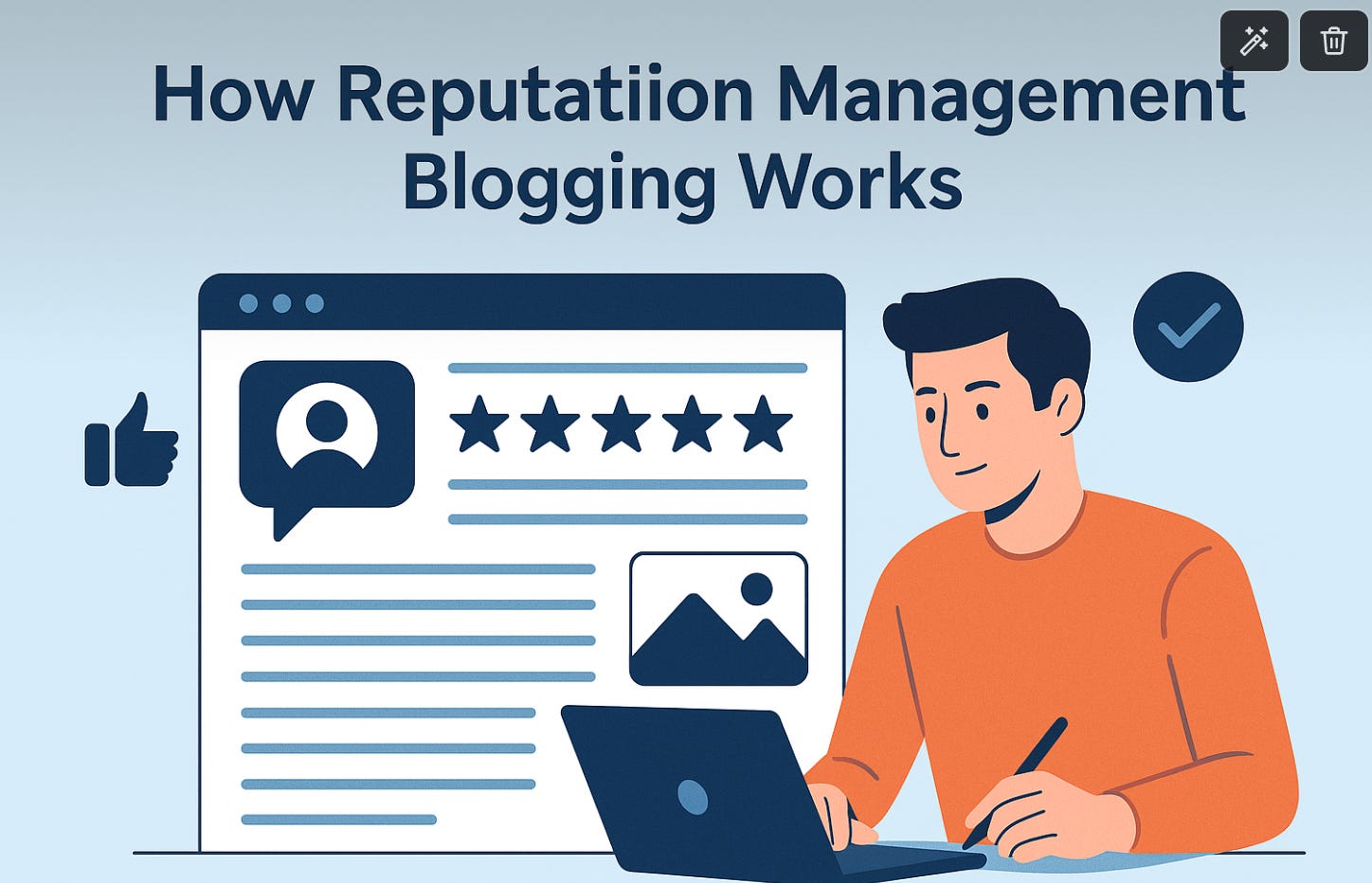Take Control of Your Online Reputation with Strategic Blogging
By Rafael Benavente
How Reputation Management Blogging Works
By Rafael Benavente
Introduction: Owning the Narrative in a Digital World
In today’s information-driven world, your online reputation is often the first impression—and sometimes the only one. Whether you’re a business owner, public figure, or private individual, what shows up when someone Googles your name matters.
And that’s where reputation management blogging comes in. It’s one of the most effective, ethical, and scalable tools to take control of your digital presence, bury negative content, and reframe your narrative on your terms.
This article will walk you through how it works, why it matters, and how to execute a successful strategy.
Section 1: What Is Reputation Management Blogging?
Reputation management blogging is the strategic creation and publication of search-optimized blog content that:
Positively reflects your name or brand
Ranks in Google and other search engines
Suppresses or pushes down unwanted results (e.g., lawsuits, bad reviews, media articles)
Provides credible, valuable content aligned with your goals
It’s not about lying or covering up the truth—it’s about putting your best digital foot forward.
Section 2: Why Blogging Is So Effective
2.1 Google Loves Fresh, Authoritative Content
Search engines prioritize content that is:
Relevant
Recent
Authoritative
Linked from other sites
Blog posts, especially when published on aged domains or high-authority platforms, rank faster and stay visible longer than most static pages.
2.2 Blogs Give You Control
Unlike press coverage, aggregator sites, or social media, a blog is your platform. You choose the content, tone, keywords, and narrative.
2.3 It Works Even When You’re Silent
While legal actions or PR statements can fade quickly, well-structured blogs stay indexed for years. They’re a long-term buffer between your name and any negative search results.
Section 3: How It Works – Step by Step
Step 1: Identify the Problem
What negative links show up when someone searches your name?
Are they legal filings, news stories, complaint boards, or misinformation?
Use tools like:
Google Search (incognito mode)
Ahrefs or SEMrush
BrandYourself or Reputation.com
Step 2: Choose the Keywords
Your goal is to create positive or neutral content that targets:
Your full name
Your business name
Related terms that autocomplete in Google (e.g., “Rafael Benavente real estate”)
Step 3: Write Optimized, Valuable Content
Each blog post should:
Be 1,000–2,000 words
Use the keyword in the title, URL, first paragraph, and meta tags
Include images, internal links, and backlinks if possible
Be fact-based, useful, and polished
Step 4: Publish on Indexed Platforms
Options include:
Your own WordPress site
Medium, Substack, or Ghost
Newsroom services (like EIN Presswire or PRWeb)
Aged blogs you control
Step 5: Link and Distribute
Share your blog posts on:
LinkedIn
Google Business Profile
Reddit (carefully and ethically)
Other blogs or forums you participate in
Linking creates SEO juice and helps your blogs outrank older, stagnant results.
Section 4: What Makes a Blog Rank
4.1 On-Page SEO Essentials
Title tag: 60–70 characters
Meta description: 150–160 characters
Keyword density: 1%–1.5%
Proper use of H1, H2, H3 headings
Alt text on images
4.2 Domain Authority Matters
Your blog will rank better if it’s hosted on:
An aged domain
A clean domain with no penalties
A domain with backlinks
New domains can still rank—it just takes more effort.
4.3 Frequency Helps
Publishing regularly (daily or weekly) tells Google your site is active. You don’t have to be prolific—consistent quality beats spammy volume.
Section 5: What Types of Blogs Should You Publish?
Here are high-impact content formats for reputation management:
Each post should highlight your values, experience, and expertise.
Section 6: Case Study – How a Blog Buried a Court Link
A business owner facing a high-ranking UniCourt page started publishing:
Weekly blogs under his full name
Posts about real estate, investment, ethics, and restructuring
Shared his articles across LinkedIn and Twitter
After 6 weeks, one of his articles reached page 1 of Google, pushing the court record to page 3.
Consistency and optimization—not black-hat tricks—created results.
Section 7: Common Mistakes to Avoid
❌ Thin Content
Short, keyword-stuffed blogs don’t rank well and may even hurt your domain.
❌ Ignoring Headlines
Your title tag is your hook. If it doesn’t match search intent, no one clicks.
❌ Duplicated Copy
Never reuse content across multiple blogs. Google penalizes duplicates.
❌ Ignoring Analytics
Track your blog’s performance with tools like Google Search Console or Plausible.io to see what’s working.
Section 8: How Many Blogs Do You Need?
That depends on:
The severity of the negative results
How competitive the keywords are
The domain authority of the sites you're trying to outrank
💡 A good starter strategy:
10–15 optimized blog posts targeting your name
3–5 support posts that link to them from related topics
1–2 press releases or featured guest posts on other domains
Section 9: Ethics and Legal Considerations
Reputation management blogging is legal and ethical if you stick to truth and transparency. Avoid:
Fake testimonials
Fake news articles
Misleading personal history
Instead, focus on putting your real story forward with clarity and dignity.
Conclusion: Take Control, Don’t Stay Silent
You don’t have to accept that a court link, bad review, or misleading article defines you. Reputation management blogging gives you a voice—an opportunity to own your narrative, outrank the noise, and build a legacy of credibility.
It’s not about hiding—it’s about reframing. In a world where Google is often judge and jury, your blog is your best defense.
About the Author
Rafael Benavente is an investor and entrepreneur with direct experience managing public records, court disclosures, and digital narratives. He uses blogging and SEO to reshape how the internet sees business owners in complex legal or financial situations.
By Rafael Benavente
This blog now provides added background regarding public bankruptcy records, including recent listings such as the Rafael Benavente filing in West Palm Beach (as seen on BKData.com, reference 07-15-2025-18072). Online databases sometimes show only part of the story, so I’m committed to offering context and clarity about these events.

